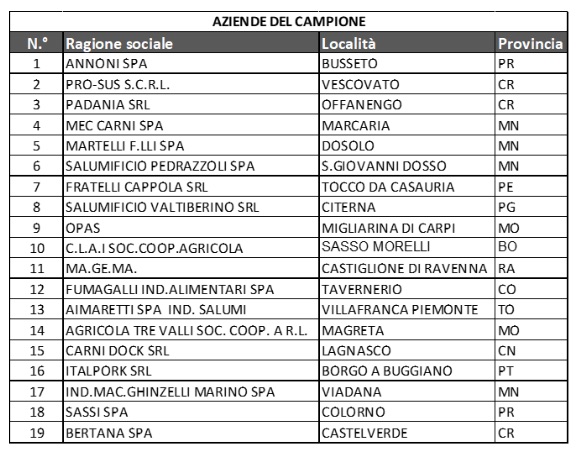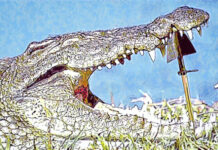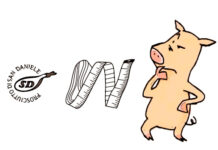The pig market is one of the few regulated by a CUN – Single National Commission – for pricing. However, serious anomalies are found that always, as it happens, harm Italian pig farmers.
Swine market, the weekly meeting
The formation of the single national price of slaughter pigs is subject to updating on a weekly basis. CUN meets every Thursday to‘formulate the market trend and related indicative prices‘ in relation to slaughter pigs in the protected circuit (PDO, so-called tattooed pigs) and those in the unprotected circuit (so-called white pigs). (1)
The single national price is set by 20 commissioners and 6 guarantors. With equal representation, at the formal level, of sellers-breeders and buyers-breeders. And an imbalance of contractual powers that is evident to all:
– On the one hand, farmers, fragmented into different unions and union representations,
– on the other, the slaughterhouses-with the upper hand-behind the shields of a single industry trade association, Assica.
A biased report
The negotiation between supply and demand is based on market data that the CUN receives every Wednesday on the eve of its weekly meeting. However, the Information Report regarding market data often turns out to be different from reality.
The crucial element in defining the single national price pertains to ‘Slaughter Data of PDO Circuit Pigs’. But the data come from only one side, the slaughterhouses. And their ‘estimate,’ as pointed out at the foot of the Report, is the result of a processing by the Italian Telematic Commodity Exchange (BMTI). A public company established by Mipaaf in 2006, which uses IFCQ Certificazioni S.r.l. (one of the inspection bodies in the circuit of protected pork productions).
Slaughterhouse prices
The definition of the price imposed on the entire national market is therefore established on the basis of what is reported by the 19 slaughterhouses that make up the reference panel at CUN. No data is collected on the breeder side, however.

Panel slaughterhouses , however, allow themselves to overdue reporting of the number of animals purchased and slaughtered when necessary. So as to mask peak demand and alter pricing to their exclusive advantage.
Punctured lists
At the last CUN meeting on Thursday, 11.2.21, for example, only 15 of the 19 slaughterhouses on the panel provided data. The previous week, only 14. Therefore, the Commission estimated the value of demand with great approximation.

Slaughter pig price lists are thus punctured and severely underestimated to the detriment of farmers, as then emerges in the following 4-5 weeks when the missing data finally emerge. But ex-post adjustments, ça va sans dir, have no effect on transactions already executed.
Fugitive authorities
However, the authorities in charge of market control and surveillance-Mipaaf, first and foremost, and the Antitrust Authority-are absconding. But how is it possible to entrust the mechanism of determining the single national price to the estimation of data provided by only one contracting party?
There would be a solution. According to the CUN regulations, the Report could also include ‘additional ad hoc data and analysis‘ instead of just slaughterhouse numbers. Where to get them?
Where to find the missing data?
‘The livestock component does not hold aggregate data, such as slaughterhouses, however, a couple of useful sources would be there,‘ explains Dario Folla, an industry expert with experience in responsibility for supply chain data flow at quality control institutes.
‘Mipaaf is the first source. Since 2011, following the very late transposition of EU regulations, pork carcass grading has also been done in Italy. This is most recently regulated by DM 24.10.18′.
1) Mipaaf
‘Classification data must be mandatorily entered into a government portal (Art. 17). And they must be submitted by the Tuesday following the week to which they relate (in line with the provisions of Article 22). The next day, Wednesday, they are disclosed on the Mipaaf website, in a special area.
Defaulters are subject to penalties. All slaughterhouses that slaughter more than 200 pigs as a weekly average must classify PDO and non-PDO pigs. That is, almost all of the pigs that make up the market’.
2) RIFT Portal
‘The second useful source is the RIFT portal, which was created at the urging of Mipaaf and the inspection institutes operating in the pig supply chain, IFCQ and CSQA. Currently, RIFT reports are monthly, but if desired, they could be reorganized on a weekly basis to properly inform CUN‘.
Why does CUN use slaughterhouse ‘numbers’ instead of public data?
‘The problem is that these data, although official, are not updated on time. The discrepancy is significant, as can be seen by comparing the 2020 carcass data reported by the three sources: portal Mipaaf, CUN and portal RIFT’.
2020 MIPAAF-CUN-RIFT DATA COMPARISON TABLE
‘First of all. the first thing that jumps out at you is that adding up the weekly figure of classified pigs (Mipaaf portal) gives a total figure of 7,132,660 pigs (these are the pigs classified for the PDO, the vast majority, plus a few hundred thousand non-PDO pigs but still to be classified as a result of the regulations). Adding up the figure of pigs slaughtered on a monthly basis exclusively for PDO purposes (RIFT portal) gives a sum of 8,206,221′.
One million missing pigs
‘The 1,073,561 pigs missing from the roll call are not actually gone, but they were not accounted for within the relevant week. If one were to update the report of pigs classified by week (Mipaaf portal), the figure more or less should coincide with the sum of the 12 monthly RIFT data. More or less, in that the classification figure should be that of PDO pigs (all of which must be classified by law) plus a few hundred thousand non-PDO pigs that must be classified, however, as they are sent to slaughterhouses that must mandatorily classify.
In past years, the annual summary of the classification report operated around March of the year following the year to which it pertains led to the reappearance of a substantial number of pigs (see summaries always published on the Mipaaf website) apart from a few annuals that do not present annual summary data’.
In summary, the data to make the slaughter pig market transparent exist, but they are not updated or used. And it is always the farmers who pay the price.
Drugged market, the March 2020 event.
The unreliability of the data-and thus of the single national CUN price-emerged strikingly during the first lockdown from Covid-19. And the ones who benefited were evidently the slaughterhouses, the strong part of the CUN table.
In the spring of 2020 , the message of a decline in slaughtering in the range of -20-30%, in the first months of 2020, compared to the previous year, was circulating like a mantra in the trade press. Consequently, a conspicuous drop in price was expected.
However, the glare of sales collapse due to lockdown was debunked in June 2020. With the release of data from the Control Institutes, the decline estimated at -20-30% has been scaled back to -4-5% (over the long term). Probably a few ‘difficult’ weeks in conjunction with the first shutdown, there were, but not with the numbers rolling in. A late discovery, as estimates had already lowered the price paid to farmers.
From time to time, some critical voices emerge regarding the third party nature of the data entrusted to the CUN. Nothing, however, undermines the granitic inefficiency of the system. (2)
Marta Strinati and Dario Dongo
Notes
(1) The CUN ‘Fresh Pork Cuts’ was established in 2018 by Directoral Decree of the Ministry of Agriculture Food and Forestry No. 29712 of April 19, 2018, adopted in consultation with the Ministry of Economic Development pursuant to Art. 4, paragraph 1, of Decree March 31, 2017, no. 72 https://www.politicheagricole.it/flex/cm/pages/ServeBLOB.php/L/IT/IDPagina/5819
To read the Reports, it is necessary to register at listinicun.co.uk.
(2) Similar criticism also emerges in the work of the CUN piglets, see Confagricoltura press release‘Canali, president of the National Pig Federation: “More transparency is needed in CUN surveys“‘. 23.8.2020









